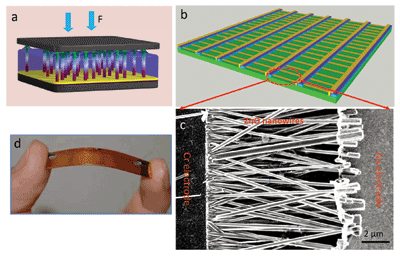Nanogenerators create self-powered nm sensors
Researchers at the Georgia Institute of Technology and collaborators combined a new generation of piezoelectric nanogenerators with two types of nanowire sensors to create what are believed to be the first self-powered nanometer-scale sensing devices that draw power from the conversion of mechanical energy. The new devices can measure the pH of liquids or detect the presence of ultraviolet light using electrical current produced from mechanical energy in the environment.
Based on arrays containing as many as 20,000 zinc oxide nanowires in each nanogenerator, the devices can produce up to 1.2 V output, and are fabricated with a chemical process designed to facilitate low-cost manufacture on flexible substrates. Tests done with nearly 1,000 nanogenerators which have no mechanical moving parts – showed that they can be operated over time without loss of generating capacity. The research was supported by the National Science Foundation, the Defense Advanced Research Projects Agency, and the U.S. Department of Energy. The sensing device has demonstrated a way to harvest energy and using it for powering nanometer-scale sensors. The researchers have a technology roadmap for scaling these nanogenerators up for practical applications.

(a) Fabrication of a vertical-nanowire integrated nanogenerator (VING). (b) Design of a lateral-nannowire integrated nanogenerator (LING) array. (c) Scanning electron microscope image of a row of laterally grown zinc oxide nanowire arrays. (d) Image of the LING structure.
The new configuration for the nanowires embeds both ends of the tiny structures in a polymer substrate. The wires then generate current as they are compressed in a flexible nanogenerator enclosure, eliminating the contact with a metallic electrode that was required in earlier devices. Because the generators are completely enclosed, they can be used in a variety of environments. According to Zhong Lin Wang, a professor in the School of Materials Science and Engineering at Georgia Tech, they can now grow the wires chemically on substrates that are foldable and flexible and the processing can now be done at substrate temperatures of less than 100C, which will allow lower cost fabrication and growth on just about any substrate.
The nanogenerators are produced using a multistep process that includes fabrication of electrodes that provide both Ohmic and Shottky contacts for the nanowires. The arrays can be grown both vertically and laterally. To maximize current and voltage, the growth and assembly requires alignment of crystalline growth, as well as the synchronization of charging and discharging cycles.
The ac output of the nanogenerators depends on the amount of strain applied. Lateral nanogenerators integrating 700 rows of zinc oxide nanowires produced a peak voltage of 1.26 V at a strain of 0.19%. In a separate nanogenerator, vertical integration of three layers of zinc oxide nanowire arrays produced a peak power density of 2.7 mW/cm3 .
The research team produced two tiny sensors that are based on zinc oxide nanowires and powered by the nanogenerators. By measuring the amplitude of voltage changes across the device when exposed to different liquids, the pH sensor can measure the acidity of liquids. An ultraviolet nanosensor depends on similar voltage changes to detect when it is struck by ultraviolet light. The new generator and nanoscale sensors open new possibilities for very small sensing devices that can operate without batteries, powered by mechanical energy harvested from the environment. Energy sources could include the motion of tides, sonic waves, mechanical vibration, the flapping of a flag in the wind, pressure from shoes of a hiker or the movement of clothing. For more information call John Toon at 404-894-6986 or e-mail jtoon@gatech.edu.
Paul O’Shea
Advertisement
Learn more about Georgia Institute of Technolog





